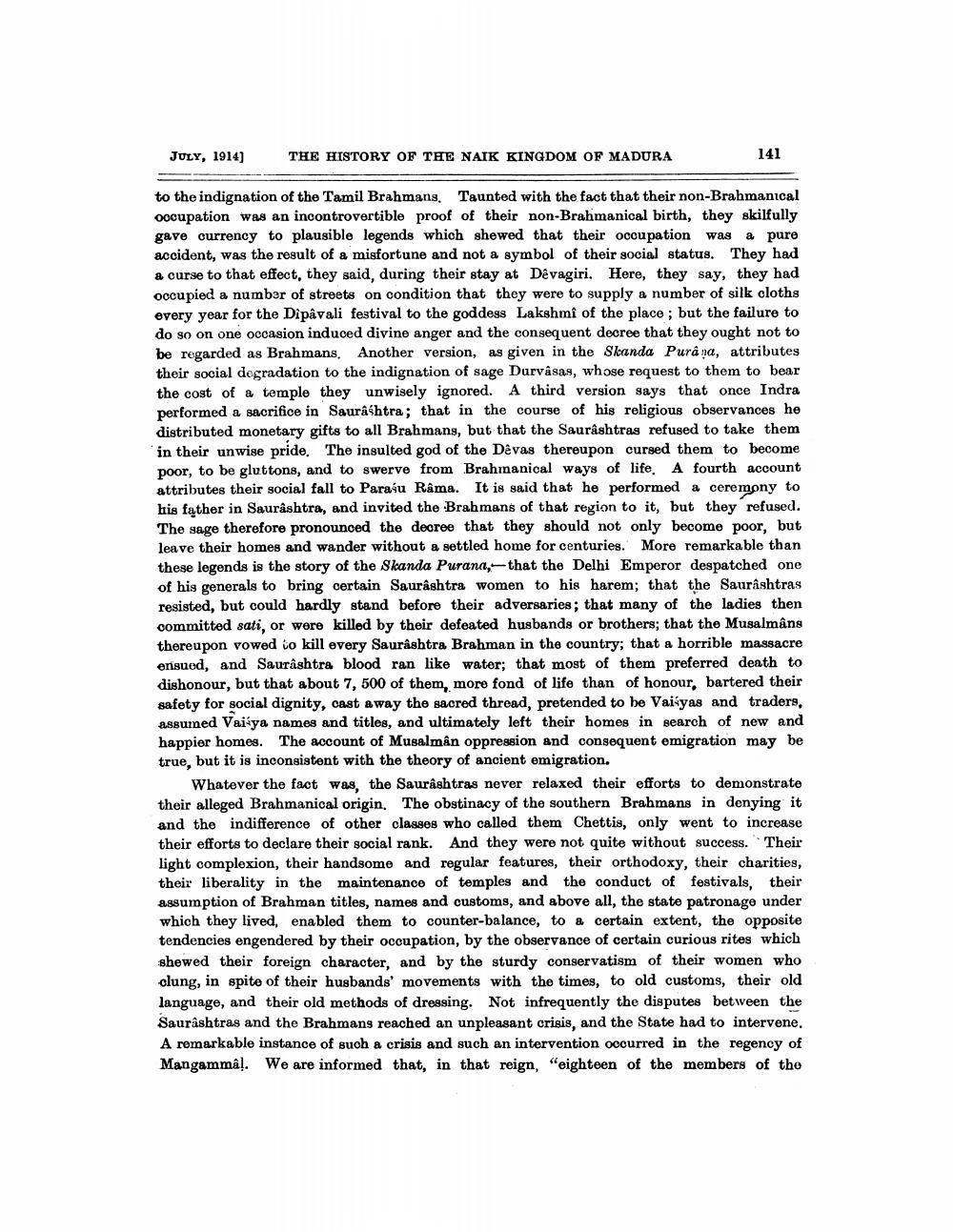________________
JULY, 1914]
THE HISTORY OF THE NAIK KINGDOM OF MADURA
141
to the indignation of the Tamil Brahmans. Taunted with the fact that their non-Brahmanical occupation was an incontrovertible proof of their non-Brahmanical birth, they skilfully gave currency to plausible legends which shewed that their occupation was a pure accident, was the result of a misfortune and not a symbol of their social status. They had a curse to that effect, they said, during their stay at Devagiri. Here, they say, they had occupied a number of streets on condition that they were to supply a number of silk cloths every year for the Dipâvali festival to the goddess Lakshmi of the place; but the failure to do so on one occasion induced divine anger and the consequent decree that they ought not to be regarded as Brahmans. Another version, as given in the Skanda Purana, attributes their social degradation to the indignation of sage Durvâsas, whose request to them to bear the cost of a temple they unwisely ignored. A third version says that once Indra performed a sacrifice in Saurashtra; that in the course of his religious observances he distributed monetary gifts to all Brahmans, but that the Saurashtras refused to take them in their unwise pride. The insulted god of the Dêvas thereupon cursed them to become poor, to be gluttons, and to swerve from Brahmanical ways of life. A fourth account attributes their social fall to Parasu Râma. It is said that he performed a ceremony to his father in Saurashtra, and invited the Brahmans of that region to it, but they refused. The sage therefore pronounced the decree that they should not only become poor, but leave their homes and wander without a settled home for centuries. More remarkable than these legends is the story of the Skanda Purana,-that the Delhi Emperor despatched one of his generals to bring certain Saurashtra women to his harem; that the Saurashtras resisted, but could hardly stand before their adversaries; that many of the ladies then committed sati, or were killed by their defeated husbands or brothers; that the Musalmâns thereupon vowed to kill every Saurashtra Brahman in the country; that a horrible massacre ensued, and Saurashtra blood ran like water; that most of them preferred death to dishonour, but that about 7, 500 of them, more fond of life than of honour, bartered their safety for social dignity, cast away the sacred thread, pretended to be Vaisyas and traders, assumed Vaisya names and titles, and ultimately left their homes in search of new and happier homes. The account of Musalmân oppression and consequent emigration may be true, but it is inconsistent with the theory of ancient emigration.
Whatever the fact was, the Saurashtras never relaxed their efforts to demonstrate their alleged Brahmanical origin. The obstinacy of the southern Brahmans in denying it and the indifference of other classes who called them Chettis, only went to increase their efforts to declare their social rank. And they were not quite without success. Their light complexion, their handsome and regular features, their orthodoxy, their charities, their liberality in the maintenance of temples and the conduct of festivals, their assumption of Brahman titles, names and customs, and above all, the state patronage under which they lived, enabled them to counter-balance, to a certain extent, the opposite tendencies engendered by their occupation, by the observance of certain curious rites which shewed their foreign character, and by the sturdy conservatism of their women who clung, in spite of their husbands' movements with the times, to old customs, their old language, and their old methods of dressing. Not infrequently the disputes between the Saurashtras and the Brahmans reached an unpleasant crisis, and the State had to intervene. A remarkable instance of such a crisis and such an intervention occurred in the regency of Mangammal. We are informed that, in that reign, "eighteen of the members of the




